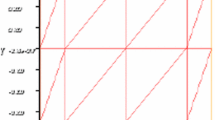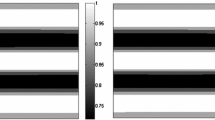Abstract
This paper is concerned with numerical approximation of some two-dimensional Keller–Segel chemotaxis models, especially those generating pattern formations. The numerical resolution of such nonlinear parabolic–parabolic or parabolic–elliptic systems of partial differential equations consumes a significant computational time when solved with fully implicit schemes. Standard linearized semi-implicit schemes, however, require reasonable computational time, but suffer from lack of accuracy. In this work, two methods based on a single-layer neural network are developed to build linearized implicit schemes: a basic one called the each step training linearized implicit method and a more efficient one, the selected steps training linearized implicit method. The proposed schemes, which make use also of a spatial finite volume method with a hybrid difference scheme approximation for convection–diffusion fluxes, are first derived for a chemotaxis system arising in embryology. The convergence of the numerical solutions to a corresponding weak solution of the studied system is established. Then the proposed methods are applied to a number of chemotaxis models, and several numerical tests are performed to illustrate their accuracy, efficiency and robustness. Generalization of the developed methods to other nonlinear partial differential equations is straightforward.















Similar content being viewed by others
References
Keller, E.F., Segel, L.A.: Initiation of slime mold aggregation viewed as an instability. J. Theor. Biol. 26, 399–415 (1970)
Painter, K.J.: Mathematical models for chemotaxis and their applications in self-organisation phenomena. J. Theor. Biol. 481, 162–182 (2019)
Akhmouch, M., Benzakour Amine, M.: A time semi-exponentially fitted scheme for chemotaxis-growth models. Calcolo 54(2), 609–641 (2017)
Jüngel, A., Leingang, O.: Blow-up of solutions to semi-discrete parabolic-elliptic Keller–Segel models. Discrete Contin. Dyn. Syst. Ser. B 24, 609–641 (2019)
Huang, X., Xiao, X., Zhao, J., Feng, X.: An efficient operator-splitting FEM-FCT algorithm for 3D chemotaxis models. Eng. Comput. (2019). https://doi.org/10.1007/s00366-019-00771-8
Xiao, X., Feng, X., He, Y.: Numerical simulations for the chemotaxis models on surfaces via a novel characteristic finite element method. Comput. Math. Appl. 78(1), 20–34 (2019)
Zhang, Y., Zhang, J.: The splitting mixed element method for parabolic equation and its application in chemotaxis model. Appl. Math. Comput. 313, 287–300 (2017)
Sulman, M., Nguyen, T.: A positivity preserving moving mesh finite element method for the Keller–Segel chemotaxis model. J. Sci. Comput. 80(1), 649–666 (2019)
Zhang, R., Zhu, J., Loula, A.F., Yu, X.: Operator splitting combined with positivity-preserving discontinuous Galerkin method for the chemotaxis model. J. Comput. Appl. Math. 302, 312–326 (2016)
Liu, J.G., Wang, L., Zhou, Z.: Positivity-preserving and asymptotic preserving method for 2D Keller–Segel equations. Math. Comput. 87(311), 1165–1189 (2018)
Li, X.H., Shu, C.W., Yang, Y.: Local discontinuous Galerkin method for the Keller–Segel chemotaxis model. J. Sci. Comput. 73, 943–967 (2017)
Dehghan, M., Abbaszadeh, M., Mohebbi, A.: A meshless technique based on the local radial basis functions collocation method for solving parabolic-parabolic Patlak-Keller-Segel chemotaxis model. Eng. Anal. Bound. Elem. 56, 129–144 (2015)
Cancès, C., Ibrahim, M., Saad, M.: Positive nonlinear CVFE scheme for degenerate anisotropic Keller–Segel system. SMAI J. Comput. Math. 3, 1–28 (2017)
Oster, G.F., Murray, J.D.: Pattern formation models and developmental constraints. J. Expl. Zool. 251, 186–202 (1989)
Murray, J.D., Deeming, D.C., Ferguson, M.W.J.: Size-dependent pigmentation-pattern formation in embryos of Alligator mississippiensis: time of initiation of pattern generation mechanism. Proc. R. Soc. B 239, 279–293 (1990)
Akhmouch, M., Benzakour Amine, M.: A corrected decoupled scheme for chemotaxis models. J. Comput. Appl. Math. 323, 36–52 (2017)
Aida, M., Tsujikawa, T., Efendiev, M., Yagi, A., Mimura, M.: Lower estimate of the attractor dimension for a chemotaxis growth system. J. Lond. Math. Soc. 74(2), 453–474 (2006)
Strehl, R., Sokolov, A., Kuzmin, D., Horstmann, D., Turek, S.: A positivity-preserving finite element method for chemotaxis problems in 3D. J. Comput. Appl. Math. 239, 290–303 (2013)
Strehl, R., Sokolov, A., Kuzmin, D., Turek, S.: A flux-corrected finite element method for chemotaxis problems. Comput. Methods Appl. Math. 10(2), 219–232 (2010)
Akhmouch, M., Benzakour Amine, M.: Semi-implicit finite volume schemes for a chemotaxis-growth model. Indag. Math. 27(3), 702–720 (2016)
Horstmann, D.: From 1970 until now: the Keller–Segel model in chemotaxis and its consequences I. Jahresber. Dtsch. Math. Ver. 105, 103–165 (2003)
Hillen, T., Painter, K.J.: A user’s guide to PDE models for chemotaxis. J. Math. Biol. 58, 183–217 (2009)
Perthame, B.: Transport Equations in Biology. Birkhäuser, Basel (2007)
Winkler, M.: Boundedness in the higher-dimensional parabolic-parabolic chemotaxis system with logistic source. Commun. Partial Diff. Eqn. 35, 1516–1537 (2010)
Hillen, T., Painter, K.: Global existence for a parabolic chemotaxis model with prevention of overcrowding. Adv. Appl. Math. 26(4), 280–301 (2001)
Painter, K.J., Hillen, T.: Volume-filling and quorum-sensing in models for chemosensitive movement. Can. Appl. Math. Quart. 10(4), 501–543 (2002)
Murray, J.D.: Mathematical Biology, vol. 2, 3rd edn. Springer, Berlin (2003)
Andreianov, B., Bendahmane, M., Saad, M.: Finite volume methods for degenerate chemotaxis model. J. Comput. Appl. Math. 235(14), 4015–4031 (2011)
Chamoun, G., Saad, M., Talhouk, R.: Monotone combined edge finite volume-finite element scheme for anisotropic Keller–Segel model. Numer. Methods Partial Differ. Equ. 30(3), 1030–1065 (2014)
Saito, N.: Conservative upwind finite-element method for a simplified Keller–Segel system modelling chemotaxis. IMA J. Numer. Anal. 27, 332–365 (2007)
Zhou, G., Saito, N.: Finite volume methods for a Keller–Segel system: discrete energy, error estimates and numerical blow-up analysis. Numerische Mathematik 135(1), 265–311 (2017)
Ibrahim, M., Saad, M.: On the efficacy of a control volume finite element method for the capture of patterns for a volume-filling chemotaxis model. Comput. Math. Appl. 68(9), 1032–1051 (2014)
Filbet, F.: A finite volume scheme for the Patlak–Keller–Segel chemotaxis model. Numer. Math. 104(4), 457–488 (2006)
Lagaris, I.E., Likas, A., Fotiadis, D.I.: Artificial neural networks for solving ordinary and partial differential equations. IEEE Trans. Neural Netw. 9(5), 987–1000 (1998)
Lagaris, I.E., Likas, A.C., Papageorgiou, D.G.: Neural-network methods for boundary value problems with irregular boundaries. IEEE Trans. Neural Netw. 11(5), 1041–1049 (2000)
Shirvany, Y., Hayati, M., Moradian, R.: Multilayer perceptron neural networks with novel unsupervised training method for numerical solution of the partial differential equations. Appl. Soft Comput. 9(1), 20–29 (2009)
Mai-Duy, N., Tran-Cong, T.: Numerical solution of differential equations using multiquadric radial basis function networks. Neural Netw. 14(2), 185–199 (2001)
Aminataei, A., Mazarei, M.M.: Numerical solution of Poisson’s equation using radial basis function networks on the polar coordinate. Comput. Math. Appl. 56(11), 2887–2895 (2008)
Jianyu, L., Siwei, L., Yingjian, Q., Yaping, H.: Numerical solution of elliptic partial differential equation using radial basis function neural networks. Neural Netw. 16, 729–734 (2003)
Sun, H., Hou, M., Yang, Y., Zhang, T., Weng, F., Han, F.: Solving partial differential equation based on Bernstein neural network and extreme learning machine algorithm. Neural Process. Lett. 50(2), 1153–1172 (2019)
Mall, S., Chakraverty, S.: Single layer Chebyshev neural network model for solving elliptic partial differential equations. Neural Process. Lett. 45(3), 825–840 (2017)
Rudd, K., Ferrari, S.: A constrained integration (CINT) approach to solving partial differential equations using artificial neural networks. Neurocomputing. 155, 277–285 (2015)
Beidokhti, R.S., Malek, A.: Solving initial-boundary value problems for systems of partial differential equations using neural networks and optimization techniques. J. Franklin. Inst. 346(9), 898–913 (2009)
Sirignano, J., Spiliopoulos, K.: DGM: a deep learning algorithm for solving partial differential equations. J. Comput. Phys. 375, 1339–1364 (2018)
Weinan, E., Han, J., Jentzen, A.: Deep learning-based numerical methods for high-dimensional parabolic partial differential equations and backward stochastic differential equations. Commun. Math. Stat. 5(4), 349–380 (2017)
Eymard, R., Gallouët, T., Herbin, R.: Finite volume methods. In: Ciarlet, P.G., Lions, J.L. (eds.) Handbook of Numerical Analysis Volume VII, pp. 713–1020. North-Holland, Amsterdam (2000)
Spalding, D.B.: A novel finite difference formulation for differential expressions involving both first and second derivatives. Int. J. Numer. Methods Eng. 4(4), 551–559 (1972)
Bessemoulin-Chatard, M., Chainais-Hillairet, C., Filbet, F.: On discrete functional inequalities for some finite volume schemes. IMA J. Numer. Anal. 35(3), 1125–1149 (2015)
Chainais-Hillairet, C., Liu, J.-G., Peng, Y.-J.: Finite volume scheme for multi-dimensional drift-diffusion equations and convergence analysis. Math. Mod. Numer. Anal. 37, 319–338 (2003)
Yu, H., Wilamowski, B.M.: Levenberg–Marquardt training. Ind. Electron. Handb. 5(12), 1–12 (2011)
Tan, H.H., Lim, K.H.: Review of second-order optimization techniques in artificial neural networks backpropagation. In: IOP Conference Series: Materials Science and Engineering, vol. 495, no. 1, p. 012003. IOP Publishing (2019)
Hayashi, Y., Sakata, M., Gallant, S. I.: Multi-layer versus single-layer neural networks and an application to reading hand-stamped characters. In: International Neural Network Conference, pp. 781–784. Springer, Dordrecht (1990)
Al-kaf, H.A.G., Chia, K.S., Alduais, N.A.M.: A comparison between single layer and multilayer artificial neural networks in predicting diesel fuel properties using near infrared spectrum. Petr. Sci. Technol. 36(6), 411–418 (2018)
Woodward, D.E., Tyson, R., Myerscough, M.R., Murray, J.D., Budrene, E.O., Berg, H.C.: Spatio-temporal patterns generated by Salmonella typhimurium. Biophys. J. 68(5), 2181–2189 (1995)
Thar, R., Kühl, M.: Complex pattern formation of marine gradient bacteria explained by a simple computer model. FEMS Microbiol. Lett. 246(1), 75–79 (2005)
Budrene, E.O., Berg, H.C.: Dynamics of formation of symmetrical patterns of chemotactic bacteria. Nature 376, 49–53 (1995)
Acknowledgements
The author would like to thank the anonymous referees for their constructive comments, which greatly improve the paper. The author would like to thank also Hamza Benzakour Amine and Meryeme Benzakour Amine for their help.
Author information
Authors and Affiliations
Corresponding author
Additional information
Publisher's Note
Springer Nature remains neutral with regard to jurisdictional claims in published maps and institutional affiliations.
Rights and permissions
About this article
Cite this article
Benzakour Amine, M. Linearized Implicit Methods Based on a Single-Layer Neural Network: Application to Keller–Segel Models. J Sci Comput 85, 4 (2020). https://doi.org/10.1007/s10915-020-01310-0
Received:
Revised:
Accepted:
Published:
DOI: https://doi.org/10.1007/s10915-020-01310-0
Keywords
- Linearized scheme
- Neural networks
- Finite volume method
- Keller–Segel models
- Partial differential equations




